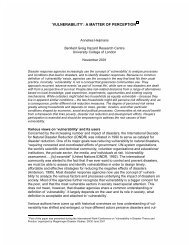SUPER CYCLONE SIDR 2007 Impacts and Strategies for ... - nirapad
SUPER CYCLONE SIDR 2007 Impacts and Strategies for ... - nirapad
SUPER CYCLONE SIDR 2007 Impacts and Strategies for ... - nirapad
Create successful ePaper yourself
Turn your PDF publications into a flip-book with our unique Google optimized e-Paper software.
Ministry of Food <strong>and</strong> Disaster Management<br />
the parallel FAO assessment mission, <strong>and</strong> extensively used government estimates on the immediate<br />
impact of the disaster as well as baseline in<strong>for</strong>mation from censuses <strong>and</strong> surveys.<br />
It is worth noting that the population census reports about 300,000 households where the main source<br />
of income is a non-farm business. Out of more than 130,000 non-farm businesses in the four districts,<br />
it is estimated that about 35,000 (26.9% of the total) was still not working by late December, due to<br />
the effects of the cyclone, including:<br />
• Destruction of premises<br />
• Breakdown or loss of equipment<br />
• Loss of inventory (raw materials, products)<br />
• Persistent interruption of electricity in some locations<br />
• Roads destroyed in some locations, isolating businesses <strong>and</strong> impeding flow of inputs <strong>and</strong> outputs<br />
(except through waterways when feasible)<br />
The main types of businesses affected are:<br />
• Saw mills<br />
• Rice mills<br />
• Pottery factories<br />
• Marketplaces <strong>and</strong> shops<br />
• Others (small hotels, restaurants, blacksmiths, etc).<br />
Since some of the businesses are owned by more than one family, this situation is estimated to<br />
severely affect the livelihoods of about 45,000 business-owning families, not counting their employees.<br />
Other businesses initially affected by the cyclone have been repaired by their owners, or had<br />
electricity or roads restored by the Government, <strong>and</strong> have resumed their usual activities.<br />
In addition to the loss of wage jobs, this section includes additional supply of labour seeking wage<br />
employment upon the loss on some non-wage employment.<br />
• Loss of non-farm wage jobs. It is estimated that about 50,000 wage workers in micro <strong>and</strong> macro<br />
establishments were permanently dismissed or temporarily suspended as a result of damages<br />
sustained by their employers.<br />
• Loss of farm wage jobs. By FAO estimates, about 35,000 seasonal wage jobs were lost by the<br />
failure of the rice harvest alone. However, this is only part of the picture. Total wage jobs in the<br />
agricultural sector are estimated (as of <strong>2007</strong>) at about 200,000 (there were 195,000 farm labourers<br />
in 2001), <strong>and</strong> probably half of them are in want of a job in the short term.<br />
• Additional supply of wage labour from non-farm business households. At a modest rate of one<br />
person per affected household, it is estimated that 45,000 people are seeking employment as a<br />
result of the closure of their usual business establishment due to cyclone damage.<br />
• Additional supply of casual wage labour from farmer <strong>and</strong> fishermen households. Since some<br />
agricultural activities were only slightly damaged (e.g. shrimp), <strong>and</strong> only some fishing families<br />
lost their boats or nets, it is estimated that about 25% of those households, or 9% of all households,<br />
will send an average of one person to the labour market in search of casual employment.<br />
This amounts to about 95,000 people in the four districts.<br />
<strong>Strategies</strong><br />
Page 38












